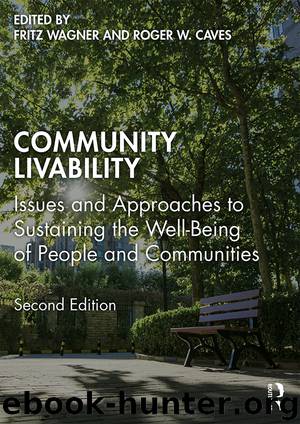Community Livability by Fritz Wagner;Roger Caves;

Author:Fritz Wagner;Roger Caves;
Language: eng
Format: epub
ISBN: 9781351619639
Publisher: Taylor & Francis (CAM)
Published: 2020-02-26T16:00:00+00:00
Environment/Climate Change
Toronto is a green city. It has a vast greenspace network as well as ravines and an increasingly appealing waterfront. The Greater Toronto Area itself is surrounded by a Greenbelt. The Greenbelt was established in 2005 by the provincial government to contain the Greater Golden Horseshoe area and prevent urban sprawl. The Greenbelt contains more than 2 million acres of protected lands (Friends of the Greenbelt, n.d.). It protects valuable agricultural lands and provides water filtration, flood control, climate stabilization, wildlife habitat, and recreation space (Wilson, 2008). As one of the world’s largest protected greenbelts, it is part of a crucial natural infrastructure for mitigating the effects of climate change.
As of May 2009, the City of Toronto is the first city in North America to have a green roof bylaw (City of Toronto, n.d.b). This aims to allow Toronto’s buildings to mitigate their contribution to the urban heat-island effect. Further environmentally friendly building policies can be found in Toronto’s Green Standard, a building emissions standard mandatory as of 2010 (City of Toronto, n.d.c).
In 2016, Toronto joined the ranks of 100 Resilient Cities through a grant by the Rockefeller Centre. The Chief Resilience Office is responsible for assessing Toronto’s resilience, meaning the way it can best respond to physical, social, and economic shocks and stressors that may impact the city. Toronto’s Resilience Strategy is forthcoming, though the City’s concern with its environment has been one of long standing. Toronto and Region Conservation Authority (TRCA) has been tasked with flood control responsibilities since 1954, following the death of 81 people due to Hurricane Hazel (TRCA, n.d.). The TRCA has authority to acquire lands for recreation and conservation purposes. 18,000 hectares have been acquired in the Greater Toronto Area, and in the aftermath of Hurricane Hazel, municipal regulations prevent construction of new buildings on floodplains (TRCA, n.d.).
At the federal level, Canada is a party to the Paris Accord. The commitments made as a country are fulfilled at a provincial level by the Province of Ontario’s Climate Change Action Plan. The Climate Change Action Plan (2016) focuses on the following action areas: transportation, buildings and homes, land-use planning, industry and business, collaboration with indigenous communities, research and development, government, agriculture, forests, and lands. At the municipal level, Toronto’s TransformTO Climate Action Plan sets 2050 targets for greenhouse gas emissions and notes that since 1990 the city’s emissions have lowered by 24% (City of Toronto, 2016a).
Download
This site does not store any files on its server. We only index and link to content provided by other sites. Please contact the content providers to delete copyright contents if any and email us, we'll remove relevant links or contents immediately.
Kathy Andrews Collection by Kathy Andrews(11278)
The remains of the day by Kazuo Ishiguro(8340)
Paper Towns by Green John(4754)
Spare by Prince Harry The Duke of Sussex(4747)
The Body: A Guide for Occupants by Bill Bryson(4539)
Industrial Automation from Scratch: A hands-on guide to using sensors, actuators, PLCs, HMIs, and SCADA to automate industrial processes by Olushola Akande(4434)
Be in a Treehouse by Pete Nelson(3622)
Harry Potter and the Goblet Of Fire by J.K. Rowling(3581)
Never by Ken Follett(3489)
Machine Learning at Scale with H2O by Gregory Keys | David Whiting(3442)
Goodbye Paradise(3413)
The Remains of the Day by Kazuo Ishiguro(3100)
Into Thin Air by Jon Krakauer(3099)
The Cellar by Natasha Preston(3059)
The Genius of Japanese Carpentry by Azby Brown(3010)
Drawing Shortcuts: Developing Quick Drawing Skills Using Today's Technology by Leggitt Jim(2911)
120 Days of Sodom by Marquis de Sade(2908)
Fairy Tale by Stephen King(2856)
The Man Who Died Twice by Richard Osman(2777)
